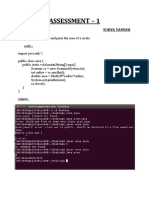0% found this document useful (0 votes)
40 views28 pagesJava 1 To 8 Praclab
This is Java Practical file
Uploaded by
navinpratpsingh007Copyright
© © All Rights Reserved
We take content rights seriously. If you suspect this is your content, claim it here.
Available Formats
Download as DOCX, PDF, TXT or read online on Scribd
0% found this document useful (0 votes)
40 views28 pagesJava 1 To 8 Praclab
This is Java Practical file
Uploaded by
navinpratpsingh007Copyright
© © All Rights Reserved
We take content rights seriously. If you suspect this is your content, claim it here.
Available Formats
Download as DOCX, PDF, TXT or read online on Scribd
/ 28























































































